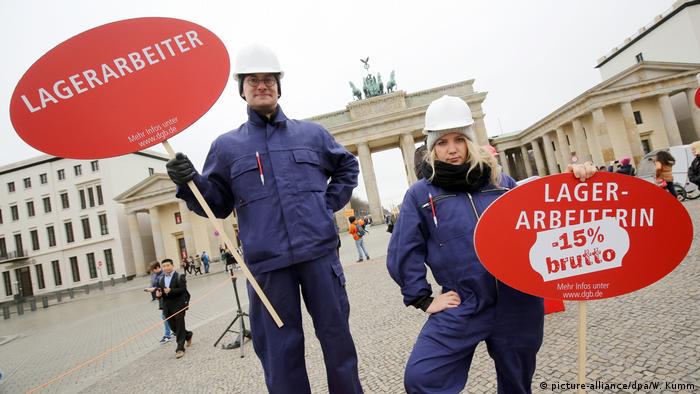BUSINESS
Equal Pay Day: Why Europe is still grappling with gender pay gap
Even though the EU was founded on the principle of gender equality, nearly three decades later women in the bloc still earn on average 13% less than men. The answer lies in the unpaid care work done by women.
A male and a femal construction worker showing the difference in their pay during a protest in front of Berlin’s landmark Brandenburg Gate
Are quotas and other political interventions the right tools for getting women their fair share?
In the past year, the world witnessed a series of compounding crises including natural disasters due to climate change, violent conflicts and large-scale displacement in addition to an ongoing global pandemic.
COVID-19 already caused stress on gender parity, and academics are now calling for the need to study the impact of the ongoing energy crisis in Europe on the pay disparity between men and women.
What is the gender pay gap?
The so-called gender pay gap is the difference in average gross earnings between men and women. It is often based on salaries paid directly to employees before income tax and social security contributions.
According to the Global Gender Gap Report 2022 by the World Economic Forum, it will take a whopping 132 years to reach full parity and close the gender gap. While Europe has the second-highest level of gender parity globally, the report estimates that the region still has at least 60 years to reach parity.
What causes the gender pay gap?
Studies have shown over the years more men tend to be employed in higher-paying jobs like construction and mining which require substantial risk, or in the finance and insurance sectors.
To begin with, fewer women work compared with men. Women work more hours per week than men but they spend more hours doing unpaid work — a fact that might also be affected by their career choices.
Women, who are disproportionately assigned to be the primary caregivers for children, tend to pick jobs that offer flexible or shorter working hours. This has led to an unequal burden for women to take career breaks to facilitate maternity and child care.
A picture of a father feeding his 14-month-old daughter a snack while his other daughter looks on at a playground in Berlin, Germany
Men spend just of third of the time women do on unpaid work
Why does it matter?
A disparity in pay translates to a range of problems for women. Direct consequences include poorer access to health care, welfare, education and financial security, especially in old age.
Other effects compound the problem: unequal career paths, gaps in financial literacy and a significant gap in access to wealth-building resources and wealth accumulated over a lifetime.
This also means that fewer women rise to leadership roles. Less than 8% of top companies worldwide have women CEOs.
Further, more women are employed in low-wage jobs doing domestic, temporary or part-time work, making them ineligible for many state or company benefits. For example, during the pandemic, many women in Europe could not access government-funded income support, as protection schemes were not often available in the sectors of their work.
A picture of a mother working from home, while her three children are also at home because the schools were closed during a coronavirus-induced lockdown
The COVID-19 pandemic is said to have reverted progress on gender equality
Are gender pay gap figures representative of reality?
Economists believe the pay gap is a good starting point to understanding the extent of gender disparity in an economy. However, it is not a good measure of cumulative pay gap over a prolonged time, said Eric Thode, director for Sustainable Social Market Economies at the German nonprofit Bertelsmann Foundation.
Owing to comparatively longer career breaks and part- or short-time employment during their work life, “women tend to earn far less than men,” he told DW. “If we account for what women lose over these breaks, during part-time work, and study the overall economic life cycle, women [in Germany] earn 40% less than men cumulatively.”
He explained that if women did not take any break for maternity or child care, then the cumulative gender pay gap across the life cycle would be “comparable to the gap in hourly wages often used by international organizations.”
Play Video3:43 min
How to negotiate more successfully as a woman
How do we address the problem?
Better and equal access to education, employment and pension is a necessary first step to narrowing the gender pay gap.
Furthermore, reducing the burden of unpaid care work on women could elevate women’s wages as they would have more time for paid work. A 2010 study from Sweden showed that for every month of parental leave used by fathers, the mother’s wages went up by 7%.
Additionally, a key strategy proposed by the European Parliament is to enforce rules that obligate employers to make salaries transparent. In April, the parliament voted in favor of requiring EU companies with at least 50 employees to disclose information that makes it easier for colleagues to compare salaries and expose any existing gender pay gap in their organization.
Regulations like these have had success in countries like Iceland, which has closed 90% of the gender pay gap. While improving women’s pay might be a bitter pill for companies to swallow now, eventually, it could have both social and economic benefits.
Edited by: Uwe Hessler
Date 18.09.2022
Author Sushmitha Ramakrishnan
Related Subjects Gender equality, Merkel’s Era: The Women of Power
Keywords gender gap, equal pay, work, gender equality
Feedback: Send us your feedback.
Print Print this page
Permalink https://p.dw.com/p/4GwN2

























